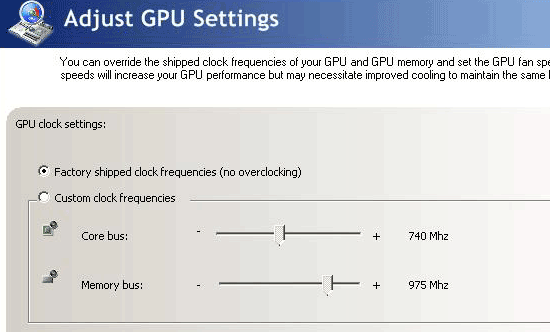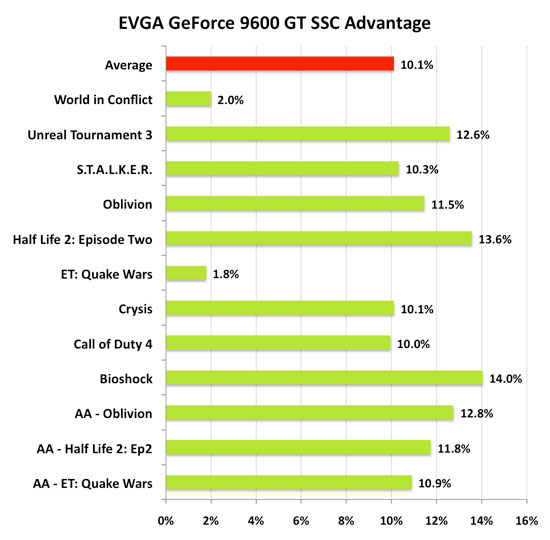When the Smoke Clears & Prices Settle: GeForce 9600 GT vs. Radeon HD 3870
by Anand Lal Shimpi on February 22, 2008 12:00 AM EST- Posted in
- GPUs
The Value in Overclocking: EVGA’s 9600 GT SSC
EVGA is currently shipping the highest clocked GeForce 9600 GT. Dubbed the EVGA GeForce 9600 GT SSC, this card runs its core at 740MHz and memory at 1.950GHz (data rate).
| Game | Stock GeForce 9600 GT | EVGA GeForce 9600 GT SSC | Percent Increase |
| Core | 650MHz | 740MHz | 13.8% |
| Shader | 1.625GHz | 1.835GHz | 12.9% |
| Memory | 1.80GHz | 1.95GHz | 8.3% |
You can buy this card directly from EVGA for $219.99, or if you shop around you'll shave off about $10, pricing it 12.6% higher than the average GeForce 9600 GT. Today's question? Is it worth it?

We ran the same benchmarks from the previous page on the EVGA GeForce 9600 GT SSC card and compared it directly to the stock GeForce 9600 GT:

The overclocked EVGA actually yielded some very healthy gains in the 10 - 12% range in most of our tests, the only exceptions being World in Conflict and Quake Wars which were both around 2%. On average, EVGA managed to boost performance approximately 10% after a 12.6% increase in board price.
Given that this is a price-sensitive mid-range part, any significant increase in price had better be more than worth its corresponding increase in performance. The problem is that at $208, you're only $10 away from an 8800 GT 512MB which should have no problems outperforming the 9600 GT. The 9600 GT makes the most sense at the $169 - $179 price range, and at those price points you're going to be dealing with stock clock speeds.










44 Comments
View All Comments
dingetje - Saturday, February 23, 2008 - link
i would be very interested to see how the 9600GT 512MB stacks up against the recently released 8800GS 384MB , especially regarding overclockingZak - Friday, February 22, 2008 - link
I wish I had put my 8800GTX on eBay couple of weeks ago. Now I'm going away on vacation for 3 weeks. Perhaps when I come back the 9800GTX or 9900GTX will be out:) I wonder if it'll allow Crysis on Very High at 1920x1200. Maybe I'll give Vista a try again if SP1 comes out about the same time!Z.
Imnotrichey - Friday, February 22, 2008 - link
In yesterdays article, it said the Crysis benchmarks were ran at medium quality and got 41.5 FPS, and in this article it says its at the high quality settings.Is it the medium or high quality settings?
Im guessing they are both supposed to be medium considering my 8800 GTS gets pretty choppy at high settings.
Thorsson - Friday, February 22, 2008 - link
One of the most important pieces of info is totally missing. Which card overclocks better?Aberforth - Friday, February 22, 2008 - link
Too bad....in a few months we are going to see most demanding games ever made and then you can decide whether this is a mid-rage or low end. Future geometry shaders will prolly kill this card one day :DBigLan - Friday, February 22, 2008 - link
Any word on how stock 9600's overclock? Is it realistic to think you'll be able to match the speeds of the overclocked cards, and if so, is the maximum overclock on stock and factory-overclocked cards the same?I really don't see the point in paying a premium for factory overclocked cards, you can do it yourself for free and very little risk (just overclock in small incremements and you won't fry your card.). Paying for a better cooler makes much more sense imo.
OrSin - Friday, February 22, 2008 - link
Not sure what WoC is, but we get a few RTS games. We got 10+ FPS. And Oblivion and Bioshock might as well be FPS to me.When is the industry going to try to do something else. It seems we have to wait for Blizzard to come up with SC for people to jump on some other bandwangon.
kilkennycat - Friday, February 22, 2008 - link
Seems as if the forced price cuts on the 3850 and 3870 are likely to have reduced AMD's profit on the associated GPUs suddenly to zero. I cannot see their board partners being at all willing to swallow any part of that price cut. I suspect that AMD might have had to rebate a large part of the GPU costs to their board-partners for boards already in the pipeline to have them go along with the drastic price-cut.nVidia has 1.8 billion in the bank and AMD is ~ $3 billion in the red. nVidia can sell their GPUs to their board partners with a very low profit margin for a very long time. The forced price-cuts by AMD to match the nVidia partner prices bleed away AMD/ATi's ability to recover the huge development costs on their silicon. No development-cost recovery - can't self-finance future development. With Intel on one side and nVidia on the other and both successfully squeezing AMDs profit margins on all of AMD's new products, time is not on AMD's side. I suspect that AMD's propects for borrowing more money for product development are becoming very limited indeed with the current world-wide banking turmoil. (For a glimpse at the costs of modern GPU silicon development, the nVidia families of GPUs that power the 8xxx series took about $400million to design and bring to production... )
DerekWilson - Friday, February 22, 2008 - link
The 55nm process offers a size advantage over the 65nm process. We haven't confirmed die sizes ... so ... I might be wrong (i'm not in town and i can't check), but I think the R670 is smaller than the G94.Maybe Anand can do a quick check?
*poke
Wirmish - Friday, February 22, 2008 - link
8800 (G80) -> 484 mm²8800 (G92) -> 324 mm²
8600 (G84) -> 173 mm²
9600 (G92) -> 240 mm²
2900 (R600) -> 450 mm²
38x0 (RV670) -> 190 mm²
Do the maths.